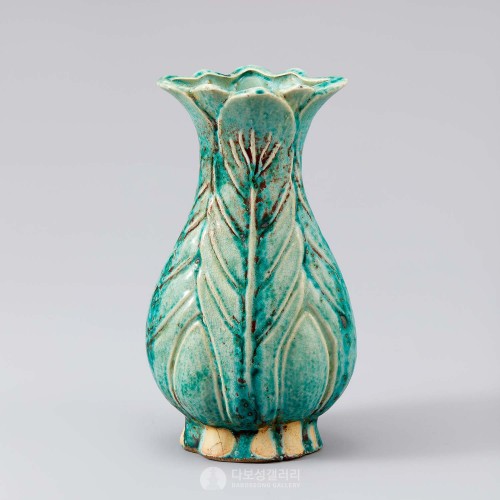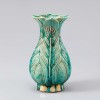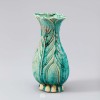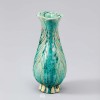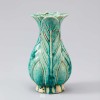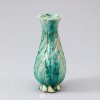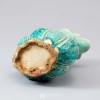본문
구연부가 활짝 핀 꽃잎처럼 넓게 벌어지고 몸체가 배추의 형상으로 만들어져 있는 북송 시요(柴窯)에서 제작된 공작남유(孔雀藍釉) 배추 모양 병입니다.
구연부에서 몸통의 저부까지 배추의 이파리 결 모양이 섬세하게 양각되어 있으며, 기면 전체에 배추의 빛깔을 닮은 청록색 유가 시유되었고 곳곳에 붉은 유약이 남아 있는 특징이 있습니다. 표면에는 미세한 빙렬이 확인되며 광택이 좋고, 굽 바닥에 출토 흔적이 그대로 남아 있습니다.
시요(柴窯)는 오대십국 후주 황제인 시세종 시영의 성을 따서 이름이 지어진 가마터로 역사적으로 저명한 황제용 가마입니다.
시요에서 생산한 자기는 주로 천청색(天靑色)이고 자기질은 윤택하며 섬세하고 아름답습니다.
━━━━━
该瓶口沿部如盛开的花瓣,瓶身呈白菜状,生产于北宋柴窑。
从口沿部到底部,白菜叶部分纹理刻画细致,整体施青绿色釉。其特点是处处施有红釉。外壁有细微的冰裂,光泽度好,底足仍留出土痕迹。
柴窑是以五代十国后周皇帝柴世宗柴荣之姓命名的窑口,是历史上著名的御窑。
柴窑瓷器颜色以天青为主,瓷质滋润细媚。
━━━━━
This cabbage-shaped vase with a flared, lobed mouth was produced at Chai kiln of the Northern Song dynasty.
Leaf grains are delicately relief-engraved from the mouth to the lower body, and the surface is glazed overall in turquoise color similar to that of cabbage, with red splays in places. On the exterior are tiny crackles, and the surface is well-polished. Traces of excavation remain on the base.
Chai kiln (柴窯) is a famous imperial kiln whose name refers to the last name of the Emperor Shizong of Later Zhou.
Chai ware porcelains usually features smooth pale-blue glazed surface and fine beauty.
